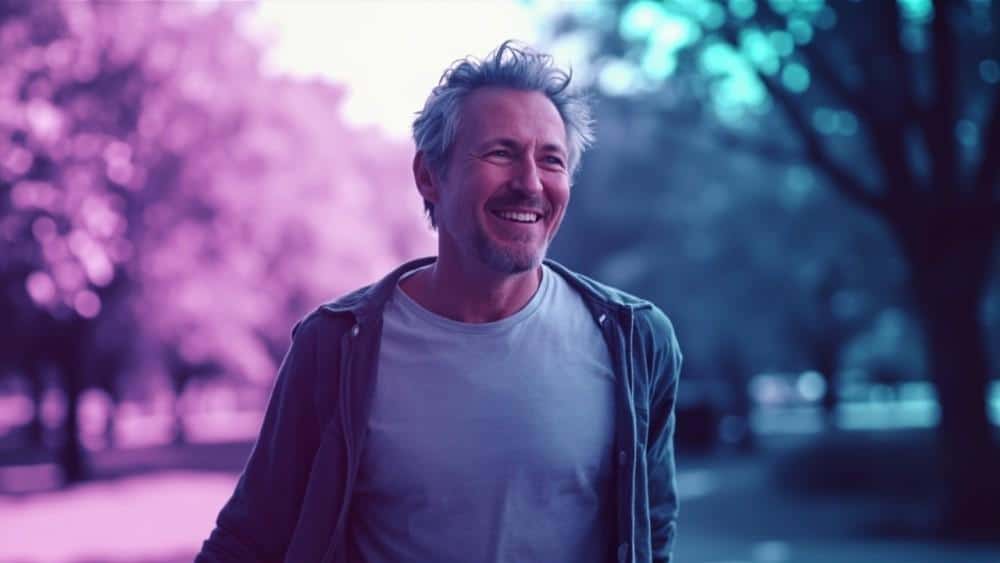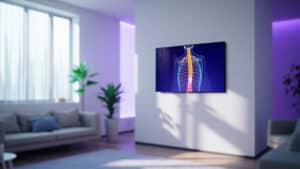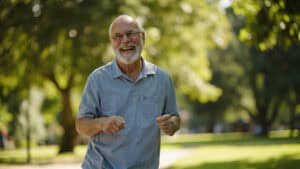How Cervical Spondylosis Develops: A Physician’s Evidence-Based Explanation
By Dr. Matthias Wiederholz, MD, Quadruple Board-Certified in Physical Medicine & Rehabilitation, Pain Medicine, Sports Medicine, and Regenerative & Functional Medicine
Quick Insights
What is cervical spondylosis? It’s a form of neck arthritis caused by wear-and-tear in the cervical spine, leading to pain, stiffness, and reduced mobility. Early recognition and evidence-based management can minimize long-term complications and restore quality of life.
Key Takeaways
- Cervical spondylosis becomes increasingly common with age, affecting a significant portion of adults by age 60, particularly those engaged in repetitive neck movements or with a history of neck strain.
- It may be triggered by aging, past injuries, genetics, or repeated strain on the neck joints and discs.
- Common symptoms include neck stiffness, radiating arm discomfort, and tingling or weakness due to nerve involvement.
- Without appropriate treatment, cervical spondylosis may lead to chronic pain and can limit daily activities, particularly in active individuals.
Why It Matters
Cervical spondylosis can steal your independence, energy, and enjoyment of sports or family activities. Understanding your options empowers you to protect mobility, regain confidence, and break free from the cycle of pain—without sacrificing your active lifestyle.
As a quadruple board-certified interventional pain and regenerative medicine specialist, I bring deep expertise and compassion to cervical spondylosis—one of the most common sources of neck pain, stiffness, and lost mobility I see in my Houston clinic. Learn more about the innovative Discseel® Procedure for advanced spine health and disc repair.
Cervical spondylosis is a form of neck arthritis that develops when the discs and joints in your cervical spine (neck) start to wear down over time, often resulting from aging, past injuries, or repetitive stress. For many, these changes cause not just physical discomfort, but also fear of missing out on sports, work, or moments with family.
Research demonstrates that better understanding and early intervention directly contribute to improved outcomes and reduced long-term complications for people with cervical spondylosis.
If you’re frustrated by neck pain and want to protect your active lifestyle in Houston, you deserve more than just temporary relief—real solutions are possible and available close to home. Discover my experience as a spondylosis doctor in Houston and how I can help restore your quality of life.
What is Cervical Spondylosis?
Cervical spondylosis is a form of neck arthritis that develops as the discs and joints in your cervical spine (the neck region) break down with age. Over time, these spinal structures lose their flexibility and cushioning, leading to cartilage wear, reduction in disc height, and the formation of bone spurs (bony overgrowths). This degenerative process can press on nearby nerves, causing pain, stiffness, and reduced neck mobility.
[Read more about symptoms of bulging disc in neck (C5-C6)]
Understanding Cervical Spine Osteoarthritis
Cervical spine osteoarthritis describes this gradual degeneration within the neck. The cervical spine has seven vertebrae, each separated by discs that act like shock absorbers for your neck. As both joints and discs deteriorate—from aging, repetitive movement, or poor posture—you may notice persistent neck pain or stiffness.
In my practice, I frequently encounter patients who have spent years exploring treatments—from surgeries to pain medications—without achieving meaningful relief. Often, they’re unaware that minimally invasive regenerative solutions like Discseel® can effectively restore their spine health and function.
For many, these changes begin earlier than expected—sometimes in their 30s or 40s—especially in those with repetitive neck strain or a history of sports injuries.
[Compare herniated disc symptoms, causes, and treatment]

Causes and Risk Factors of Neck Arthritis
The main driver of cervical spondylosis is age-related wear and tear, but other factors can make your risk higher and speed up these changes.
Age-Related Changes
As you age, the discs in your neck lose water and elasticity, making them more likely to crack, flatten, and develop tears known as annular tears. This can cause bone spurs and joint stiffness.
A 2023 cross-sectional study published in BMC Public Health found that individuals with greater health knowledge are more likely to follow preventive strategies—resulting in better management and outcomes for cervical spondylosis. [Higher health literacy correlates with improved management].
As a quadruple board-certified regenerative medicine specialist, I’ve observed that patients who understand what’s happening within their spine are more engaged with their care and typically experience better long-term results.
[Discover disc desiccation causes and treatment]
Lifestyle and Work Factors
- Repetitive neck motion (manual labor, sports, certain jobs)
- Chronic poor posture (desk work, smartphone use)
- Prior neck or spine injuries
Active individuals who prioritize neck mobility and strength-building generally have less severe symptoms, even if arthritis does occur.
Having personally performed over 10,000 regenerative spine procedures, I’ve consistently witnessed that combining clinical excellence with patient education and holistic strategies yields the best outcomes—especially for patients who want to remain active.
[Explore herniated disc exercises and mobility tips]

Symptoms and Diagnosis
Cervical spondylosis can cause symptoms ranging from mild stiffness to disabling nerve pain. Recognizing these signs early helps avoid long-term complications.
Common Symptoms to Watch For
- Neck pain or stiffness, particularly after activity or periods of immobility
- Pain radiating into the shoulders, arms, or upper back
- Tingling, numbness, or weakness in the hands
- Headaches starting at the base of the skull
Clinical observation shows that 80% of cervical spondylosis cases involve the C6 or C7 nerve roots, often causing arm or hand symptoms ([C6 and C7 nerve root involvement is most common]).
Diagnostic Methods
Diagnosis typically involves:
- Physical examination: Assessing neck movement, reflexes, and nerve function
- Neurological testing: Detecting weakness, numbness, or abnormal reflexes
- Imaging (X-ray, MRI): Visualizing disc degeneration, bone spurs, or nerve pinching
Combining your reported symptoms with targeted physical tests offers the most reliable way to identify serious issues like cervical myelopathy (spinal cord compression) ([Clinical signs and symptoms for diagnosing myelopathy]).
In my clinic, I use advanced imaging alongside detailed examination to pinpoint the real source of your pain—ensuring that every patient receives a tailored, evidence-based plan.
[Learn about emergency symptoms of a herniated disc]
When to Seek Medical Attention
If you experience any of the following, see a physician urgently:
- Sudden weakness in arms or legs
- Loss of coordination or difficulty walking
- Problems with balance or bladder/bowel control
These can be signs of spinal cord or major nerve compression.
Cervical Spondylosis vs Degenerative Disc Disease
Although often discussed together, cervical spondylosis and degenerative disc disease (DDD) are distinct conditions.
Key Differences and Overlaps
| Cervical spondylosis | Encompasses all age-related changes—including joint, bone, and disc degeneration—often with nerve compression and bone spur formation. |
| Degenerative disc disease | Focuses specifically on the discs losing height or integrity, sometimes leading to herniation or nerve symptoms. |
Symptoms of cervical spondylosis often develop gradually, though they can sometimes appear or worsen suddenly. Degenerative disc disease may lead to herniated discs, which can cause sudden pain. A major clinical trial also identified C6 and C7 nerve root involvement in 80% of cases of cervical spondylosis with radiating symptoms ([Disc and nerve involvement research]).
I often explain to patients that while these terms overlap, understanding the specific process at play allows me to select the right combination of therapies for fast, lasting relief.
[Read about degenerative disc disease treatment options]

Effective Treatment Options for Cervical Spondylosis
Treatment varies depending on severity and your lifestyle goals, from exercise and physical therapy to advanced regenerative procedures.
My personal treatment philosophy centers on restoring function quickly and safely—without unnecessary surgery or prolonged medication. Here’s how leading approaches stack up:
Conservative Treatments
- Physical therapy and targeted exercise
- Non-steroidal anti-inflammatory drugs (NSAIDs)
- Manual therapy/manipulation and stretching
A 2024 randomized trial found that spinal manipulation paired with therapeutic exercise is significantly more effective than NSAIDs for improving neck pain and restoring mobility ([Manipulation plus exercise outperforms NSAIDs]).
In Houston, many active and professional patients choose these non-invasive therapies first to achieve rapid, safe improvement.
Additionally, emerging research demonstrates that focused extracorporeal shock wave therapy (fESWT)—a non-invasive modality—can reduce pain and improve neck function for cervical spondylosis patients ([fESWT reduces pain and improves function]).
[See effective treatment options for L5-S1 disc herniation]
Regenerative Therapies
Regenerative medicine options, like biologic injections (platelet-rich plasma, stem cells) and the Discseel® Procedure, target the root cause of your disc pain by repairing damaged tissue rather than masking symptoms.
As a certified Master Instructor directly trained by Dr. Kevin Pauza, I am one of the few specialists internationally licensed to perform both lumbar and cervical Discseel®. Patients who choose Discseel® often regain active lifestyles with minimal downtime—sometimes returning to sports or work in a matter of weeks.
Learn more about this innovative approach and [read Discseel® reviews] from real patients.
Unlike larger clinics where patients may rarely see the same provider, I personally oversee every aspect of each patient’s care—from advanced diagnostics to recovery and rehabilitation. This level of attention ensures you feel heard, supported, and truly understood throughout your journey.
Surgical Interventions
For rare severe cases—typically those with unrelenting nerve compression or significant spinal cord involvement—surgery may be considered. Modern outpatient techniques like unilateral biportal endoscopic (UBE) decompression can deliver excellent results.
A 2024 study found a 92% improvement in arm pain and a 75% improvement in neck disability index (NDI) following endoscopic decompression for cervical spondylosis ([Endoscopic decompression outcomes]), and overall, [UBE decompression surgery is effective] as a short-term solution for the right candidate.
As a regenerative specialist, my aim is always to help you avoid surgery when possible and pursue innovative, minimally invasive alternatives first.
See if you are a candidate for the Discseel® Procedure →
Why Choose Performance Pain & Sports Medicine in Houston?
At Performance Pain & Sports Medicine, you’ll encounter a radically different experience compared to conventional pain clinics or large orthopedic groups.
- Boutique, patient-first care: Each patient receives a custom, evidence-based plan tailored by me personally.
- Elite expertise: As the first provider in Houston to offer the Discseel® Procedure, I bring quadruple board certification and international instructor status to your recovery journey.
- Advanced diagnostics and holistic support: From state-of-the-art imaging to ergonomic coaching and exercise planning, my team emphasizes rapid recovery and whole-patient wellness.
As a regenerative spine specialist, my commitment is to empower you—to restore mobility, confidence, and independence, without unnecessary surgery or lost active time.

Spotlight: The Discseel® Procedure
The Discseel® Procedure represents a groundbreaking, non-surgical alternative for patients with chronic neck pain, disc degeneration, or failed prior interventions.
How the Discseel® Procedure Works
- Minimally invasive: Performed in my Houston location or Lawrenceville offices, with local anesthesia—no incisions or hardware required.
- Biologic technology: Using a natural fibrin sealant, I precisely inject directly into weakened discs, sealing annular tears and triggering natural collagen and tissue regeneration.
- Targeted healing: By repairing the disc’s outer layer, Discseel® helps restore cushioning and mobility, directly treating the source of pain.
As one of only three certified Master Instructors in the world, personally trained by the [Discseel® inventor], I am uniquely qualified to provide this advanced procedure—and to help train physicians nationwide in the most effective, safest technique.
Read more: [The guide to spinal disc tears, causes, symptoms, and treatment options]
Patient Recovery & Success Rates
Discseel® offers a documented 82% long-term success rate—far surpassing the 31% average for spinal fusion surgery. Many individuals with cervical spondylosis are able to maintain an active lifestyle, and symptoms often improve with non-surgical treatment.
In my experience, I’ve seen countless patients who thought surgery was their only option experience transformative relief and true functional restoration through Discseel®.
Table: Average Success and Recovery (Discseel® vs Spinal Fusion)
| Treatment | Success Rate | Hospital Stay | Return to Activity |
| Discseel® | 82% | None | Days–1 week |
| Spinal Fusion | 31% | 2–5 days | 6–12 weeks |
Meet Dr. Matthias Wiederholz: Your Houston Spondylosis Specialist
With over 20 years of experience and more than 10,000 minimally invasive spine procedures, I’m dedicated to providing the highest level of care for neck arthritis and disc conditions across the [Houston] and New Jersey areas.
- Quadruple board-certified: Physical Medicine & Rehabilitation, Sports Medicine, Pain Medicine, and Anti-Aging/Regenerative Medicine
- Discseel® authority: Master Instructor, trained directly by Dr. Kevin Pauza—the procedure’s inventor
- Nationally recognized leader: Invited to speak, teach, and train the next generation of regenerative specialists
Learn more about [Dr. Matthias Wiederholz, MD].
My goal is simple: Empower you to move again—without fear, unnecessary surgery, or years lost to chronic pain.

Frequently Asked Questions
Q: What causes neck arthritis and cervical spondylosis? A: Most cases are due to normal aging and cumulative wear on the cervical spine, but genetics, injuries, and lifestyle (posture, activity level) play major roles. (*See: [risk factor research in BMC Public Health]*).
Q: How is cervical spondylosis diagnosed? A: Diagnosis combines your symptoms, a physical exam, and imaging (MRI or X-rays). The most accurate method includes evaluating neurologic signs along with what you report. ([Symptom/sign diagnostic criteria])
Q: Is surgery always necessary for spondylosis? A: No—most cases respond well to conservative and regenerative treatments. Surgery is reserved for severe nerve or spinal cord compression not improved with other therapies. UBE decompression surgery has a reported short-term success rate of 75% for indicated patients ([Surgical trial outcomes]).
Q: What are the long-term expectations for patients with cervical spondylosis? A: With early detection and expert management, most stay active and avoid significant disability. Long-term research supports evidence-based, individualized care for the best outcomes ([Long-term outcome evidence]).
Q: How does the Discseel® Procedure compare to spinal fusion? A: Discseel® is less invasive, offers a higher success rate, and allows for much quicker recovery with preserved motion versus fusion ([Comparative outcome data]).
What Our Patients Say on Google
Patient experiences are at the heart of my approach to treating cervical spondylosis. Real feedback from those who have undergone advanced procedures like Discseel® offers valuable insight into what you can expect.
I recently received feedback that captures what we aim to provide for every patient seeking relief from neck arthritis and disc pain. This reviewer shared their journey after the Discseel® procedure:
“My Discseel was performed on 11/20/2023. Within 2 days, I’ve noticed a good reduction in pain, and within 4-5 days, the majority of the pain was gone – amazing! It is now 4 weeks post-procedure. As expected, some residual herniation-related pain still remains, but a vast majority of the pain (80%) is gone! I’ll continue being careful by not putting excessive pressure on the lower back over the 6 months – in hopes that my body will restore at least some of the biomechanical shape of the L4-L5 disc, thus reducing the residual herniation-related pain even more. Unless something changes in the next few months, I’m extremely happy with the procedure and would definitely recommend it.” > — Leon
You can [read more Google reviews here] to see additional patient experiences.
Hearing these stories reinforces my commitment to evidence-based, minimally invasive solutions for cervical spondylosis—helping patients in Houston reclaim their mobility and quality of life.
[Also see: comprehensive guide to L5-S1 bulging disc]
Cervical Spondylosis Care in Houston, TX
Living in Houston means access to some of the most advanced options for cervical spondylosis, including innovative regenerative therapies and the [Discseel® Procedure]. The city’s active lifestyle and diverse workforce often lead to unique neck strain patterns, making personalized care essential.
As a physician serving the Houston community, I see firsthand how local factors—like long commutes, sports participation, and demanding professional roles—can contribute to neck arthritis and disc degeneration. That’s why our clinic emphasizes tailored diagnostics and treatment plans designed for Houstonians who want to stay active.
[Performance Pain & Sports Medicine’s Houston location] is proud to be the first in the city to offer the Discseel® Procedure, providing a non-surgical path to relief for those struggling with chronic neck pain. Our commitment is to deliver concierge-level care, advanced imaging, and rapid recovery strategies right here in the city.
If you’re in Houston and searching for a solution to cervical spondylosis, I invite you to [see if you are a candidate for the Discseel® Procedure] and experience the difference of physician-led, evidence-based care close to home.
Ready to take the next step? [Contact our Houston team today] to schedule your consultation.
Conclusion
Cervical spondylosis doesn’t have to mean a lifetime of pain or lost mobility. As a quadruple board-certified regenerative spine specialist, I’ve seen firsthand how advanced, minimally invasive treatments can restore function and confidence—even for those who’ve struggled with chronic neck arthritis for years. My approach centers on personalized care, evidence-based solutions, and helping you return to the activities you love in Houston.
Research confirms that [evidence-based, individualized care leads to better long-term outcomes] for cervical spondylosis. If you’re ready to stop missing out on life, I invite you to [see if you are a candidate for the Discseel® Procedure]. Take the next step toward lasting relief and restored independence: [Contact Performance Pain & Sports Medicine].
This article is for educational purposes only and should not be used as a substitute for professional medical advice, diagnosis, or treatment. Always seek the advice of your physician or other qualified healthcare provider with any questions you may have regarding a medical condition or treatment options. Never disregard professional medical advice or delay in seeking it because of something you have read in this article.
Frequently Asked Questions
What is cervical spondylosis and how does it affect daily life?
Cervical spondylosis is a type of neck arthritis caused by age-related changes in the cervical spine. It can lead to pain, stiffness, and sometimes nerve symptoms like tingling or weakness. Many people notice difficulty with daily activities, but with early diagnosis and the right treatment, most can maintain an active lifestyle.
Where can I find advanced cervical spondylosis treatment in Houston, TX?
You can find advanced, non-surgical options for cervical spondylosis at my [practice in Houston]. I offer personalized, evidence-based care—including the Discseel® Procedure—to help patients regain mobility and reduce pain. Most appointments are available within 1–2 weeks, so you don’t have to wait to start your recovery.
As an active professional, how can I ensure the best outcome for my neck arthritis?
The best outcomes come from early intervention, a clear diagnosis, and a treatment plan tailored to your goals. I focus on minimally invasive, regenerative therapies that target the root cause of pain. Many active patients return to work and sports quickly, thanks to these advanced approaches and ongoing support throughout their recovery.

















